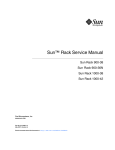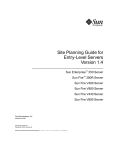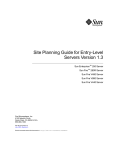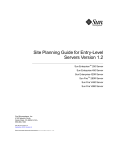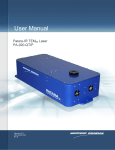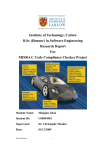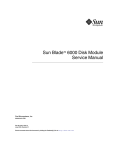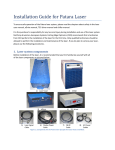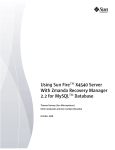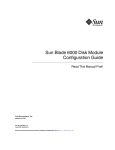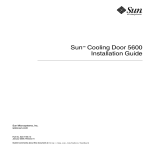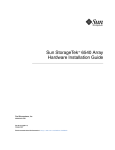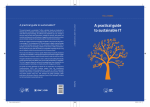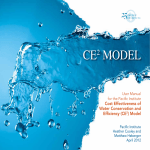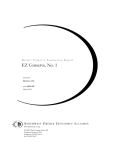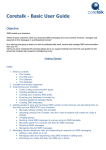Download Site Planning Guide for Sun Servers
Transcript
Site Planning Guide for Sun™ Servers Sun Microsystems, Inc. www.sun.com Part No. 819-5730-10 September 2006, Revision A Submit comments about this document at: http://www.sun.com/hwdocs/feedback Copyright 2006 Sun Microsystems, Inc., 4150 Network Circle, Santa Clara, California 95054, U.S.A. All rights reserved. Sun Microsystems, Inc. has intellectual property rights relating to technology that is described in this document. In particular, and without limitation, these intellectual property rights may include one or more of the U.S. patents listed at http://www.sun.com/patents and one or more additional patents or pending patent applications in the U.S. and in other countries. This document and the product to which it pertains are distributed under licenses restricting their use, copying, distribution, and decompilation. No part of the product or of this document may be reproduced in any form by any means without prior written authorization of Sun and its licensors, if any. Third-party software, including font technology, is copyrighted and licensed from Sun suppliers. Parts of the product may be derived from Berkeley BSD systems, licensed from the University of California. UNIX is a registered trademark in the U.S. and in other countries, exclusively licensed through X/Open Company, Ltd. Sun, Sun Microsystems, the Sun logo, Java, AnswerBook2, docs.sun.com, and Solaris are trademarks or registered trademarks of Sun Microsystems, Inc. in the U.S. and in other countries. All SPARC trademarks are used under license and are trademarks or registered trademarks of SPARC International, Inc. in the U.S. and in other countries. Products bearing SPARC trademarks are based upon an architecture developed by Sun Microsystems, Inc. The OPEN LOOK and Sun™ Graphical User Interface was developed by Sun Microsystems, Inc. for its users and licensees. Sun acknowledges the pioneering efforts of Xerox in researching and developing the concept of visual or graphical user interfaces for the computer industry. Sun holds a non-exclusive license from Xerox to the Xerox Graphical User Interface, which license also covers Sun’s licensees who implement OPEN LOOK GUIs and otherwise comply with Sun’s written license agreements. U.S. Government Rights—Commercial use. Government users are subject to the Sun Microsystems, Inc. standard license agreement and applicable provisions of the FAR and its supplements. DOCUMENTATION IS PROVIDED "AS IS" AND ALL EXPRESS OR IMPLIED CONDITIONS, REPRESENTATIONS AND WARRANTIES, INCLUDING ANY IMPLIED WARRANTY OF MERCHANTABILITY, FITNESS FOR A PARTICULAR PURPOSE OR NON-INFRINGEMENT, ARE DISCLAIMED, EXCEPT TO THE EXTENT THAT SUCH DISCLAIMERS ARE HELD TO BE LEGALLY INVALID. Copyright 2006 Sun Microsystems, Inc., 4150 Network Circle, Santa Clara, Californie 95054, États-Unis. Tous droits réservés. Sun Microsystems, Inc. possède les droits de propriété intellectuels relatifs à la technologie décrite dans ce document. En particulier, et sans limitation, ces droits de propriété intellectuels peuvent inclure un ou plusieurs des brevets américains listés sur le site http://www.sun.com/patents, un ou les plusieurs brevets supplémentaires ainsi que les demandes de brevet en attente aux les États-Unis et dans d’autres pays. Ce document et le produit auquel il se rapporte sont protégés par un copyright et distribués sous licences, celles-ci en restreignent l’utilisation, la copie, la distribution, et la décompilation. Aucune partie de ce produit ou document ne peut être reproduite sous aucune forme, par quelque moyen que ce soit, sans l’autorisation préalable et écrite de Sun et de ses bailleurs de licence, s’il y en a. Tout logiciel tiers, sa technologie relative aux polices de caractères, comprise, est protégé par un copyright et licencié par des fournisseurs de Sun. Des parties de ce produit peuvent dériver des systèmes Berkeley BSD licenciés par l’Université de Californie. UNIX est une marque déposée aux États-Unis et dans d’autres pays, licenciée exclusivement par X/Open Company, Ltd. Sun, Sun Microsystems, le logo Sun, Java, AnswerBook2, docs.sun.com, et Solaris sont des marques de fabrique ou des marques déposées de Sun Microsystems, Inc. aux États-Unis et dans d’autres pays. Toutes les marques SPARC sont utilisées sous licence et sont des marques de fabrique ou des marques déposées de SPARC International, Inc. aux États-Unis et dans d’autres pays. Les produits portant les marques SPARC sont basés sur une architecture développée par Sun Microsystems, Inc. L’interface utilisateur graphique OPEN LOOK et Sun™ a été développée par Sun Microsystems, Inc. pour ses utilisateurs et licenciés. Sun reconnaît les efforts de pionniers de Xerox dans la recherche et le développement du concept des interfaces utilisateur visuelles ou graphiques pour l’industrie informatique. Sun détient une license non exclusive de Xerox sur l’interface utilisateur graphique Xerox, cette licence couvrant également les licenciés de Sun implémentant les interfaces utilisateur graphiques OPEN LOOK et se conforment en outre aux licences écrites de Sun. LA DOCUMENTATION EST FOURNIE "EN L’ÉTAT" ET TOUTES AUTRES CONDITIONS, DÉCLARATIONS ET GARANTIES EXPRESSES OU TACITES SONT FORMELLEMENT EXCLUES DANS LA LIMITE DE LA LOI APPLICABLE, Y COMPRIS NOTAMMENT TOUTE GARANTIE IMPLICITE RELATIVE À LA QUALITÉ MARCHANDE, À L’APTITUDE À UNE UTILISATION PARTICULIÈRE OU À L’ABSENCE DE CONTREFAÇON. Please Recycle Contents Preface xi Other Resources xi How This Document Is Organized Related Documentation xii xii Documentation, Support, and Training Third-Party Web Sites xiii Sun Welcomes Your Comments 1. Site Preparation xiii xiii 1 Industry Guidelines for Site Planning Site Planning Assistance From Sun 1 2 Sun Enterprise Installation Services Sun Environmental Services Site Planning Considerations Server Configurations 2 3 4 5 Planning for Maximum Server Configurations Planning for Actual Server Configurations Using Server Configuration Data Data Center Location and Design Route to the Data Center 5 6 6 7 8 iii 2. Environmental Requirements Operating Specifications Temperature 9 10 Air Intake Temperatures Aisle Temperatures Rate of Change Humidity 9 10 10 11 11 Troubleshooting Environmental Conditions Facility Environmental Tests 12 12 Equipment Installation Environmental Tests Equipment Failure Environmental Tests Cooling and Aisle Airflow Measuring Aisle Airflow Speed 15 16 17 Fire Containment 3. 15 16 Vibration and Shock Contaminants 14 14 Calculating Cooling Requirements Acclimatization 13 17 Rackmounting the Servers 19 Cabinet and Rack Terminology Cabinet Location 19 22 Creating a Hot-Aisle/Cold-Aisle Layout 22 Maximizing Hot-Aisle/Cold-Aisle Temperature Differences Determining Aisle Clearances Determining Aisle Pitch Sun Cabinets 24 24 26 Cabinet, Rack, and Server Dimensions Rack Units iv 29 Site Planning Guide for Sun Servers • September 2006 27 23 Other Cabinet and Rack Features Cabinet Doors and Panels Load Capacity 31 31 EMI and RFI Requirements Power Sequencers Stabilization 31 32 32 32 Tools Required for Rackmounting the Servers Rackmounting Guidelines 4. 33 Server Power and Cooling Requirements Power Requirements Power Sources 35 35 36 UPS and Backup Generator Grounding 33 36 36 Emergency Power Control Power Constraints Power Supplies 38 PCI Bus Power 38 37 Heat Output and Cooling Chassis Airflow 37 39 39 Units of Measurement 40 Determining Heat Output and Cooling 41 Using Rack Location Units to Determine Heat Output and Cooling 5. Cabinet Specifications 43 Sun Cabinet Shipping Crate Specifications Sun Cabinet Physical Specifications Site Planning Checklist 43 44 Cabinet Power Sequencer Specifications 6. 41 44 47 Contents v vi Site Planning Guide for Sun Servers • September 2006 Figures FIGURE 3-1 Servers Mounted in a Cabinet and Rack 21 FIGURE 3-2 Hot-Aisle/Cold-Aisle Layout FIGURE 3-3 Seven-Tile Aisle Pitch (not to scale) FIGURE 3-4 Measuring Cabinet, Rack, and Server Depths FIGURE 3-5 EIA 310D-Compliant Cabinet and Rack 23 25 28 30 vii viii Site Planning Guide for Sun Servers • September 2006 Tables TABLE 5-1 Physical Specifications for Crated Cabinets 43 TABLE 5-2 Physical Specifications for Cabinets in Operation TABLE 5-3 Cabinet Power Sequencer Specifications TABLE 6-1 Site Planning Checklist 44 44 47 ix x Site Planning Guide for Sun Servers • September 2006 Preface The Site Planning Guide for Sun Servers, 819-5730-10, is designed to assist Sun Microsystems customers who have purchased Sun servers and who seek information about the proper way to house the servers in a data center. The material in this guide is correct as of the date of publication. For the most up-todate information, refer to the Sun Microsystems web site for your product. This book supplements the site planning product specifications which come with your server. Use the specifications as a source for the calculations described in this book. Read this site planning guide to learn more about the methodology for forecasting and calculating the physical, power and cooling requirements for your server installation. Other Resources This manual is not intended as a comprehensive guide to facility design. Customers planning to construct a new data center should read the Sun Microsystems Data Center Site Planning Guide before reading this manual. Some of the material in this manual is summarized from the Sun Microsystems Data Center Site Planning Guide. Another resource for data center design is Enterprise Data Center Design and Methodology by Rob Snevely. This is a Sun BluePrintsTM book, published by Sun Microsystems Press, a Prentice Hall title. You can find information about this book and other BluePrints books at: http://www.sun.com/books/blueprints.series.html xi How This Document Is Organized Chapter 1 describes a source for industry guidelines for site planning, site planning assistance that is available from Sun, site planning considerations, designing for server configurations, data center location, and planning the route to the data center. Chapter 2 explains environmental requirements of the data center, including temperature, humidity, acclimatization, cooling and aisle airflow, vibration and shock, contaminants, and fire containment. Chapter 3 gives information about rackmounting the servers, how to locate cabinets in the data center, and details about Sun cabinets. Chapter 4 discusses power and cooling issues relating to the servers, including power sources, power constraints, power supplies, and heat output and cooling requirements. Chapter 5 provides specifications for Sun cabinets. Chapter 6 provides a site planning checklist that you can use when planning your data center and preparing for server installations. Related Documentation The documents listed in the table are available at: http://www.sun.com Application Title Part Number Facility planning Sun Microsystems Data Center Site Planning Guide 805-5863 Enterprise Data Center Design and Methodology See BluePrints URL Sun Rack 900 Installation Manual 816-6386 Sun Rack 900 Service Manual 816-6387 Sun StorEdge Expansion Cabinet Installation and Service Manual 805-3067 Sun Fire Cabinet Installation and Reference Manual 806-2942 Sun cabinets xii Site Planning Guide for Sun Servers • September 2006 Application Title Part Number Websites Site planning support: http://www.sun.com/service/consulting/index.jsp?tsubc at=Install%20Your%20IT%20Environment&tab=4 http://www.sun.com/service/environment/ Sun Rack 900: http://www.sun.com/servers/rack/rack.html Sun BluePrints documents: http://www.sun.com/books/blueprints.series.html Documentation, Support, and Training Sun Function URL Documentation http://www.sun.com/documentation/ Support http://sunsolve.sun.com Training http://www.sun.com/training/ Third-Party Web Sites Sun is not responsible for the availability of third-party web sites mentioned in this document. Sun does not endorse and is not responsible or liable for any content, advertising, products, or other materials that are available on or through such sites or resources. Sun will not be responsible or liable for any actual or alleged damage or loss caused by or in connection with the use of or reliance on any such content, goods, or services that are available on or through such sites or resources. Sun Welcomes Your Comments Sun is interested in improving its documentation and welcomes your comments and suggestions. You can submit your comments by going to: Preface xiii http://www.sun.com/hwdocs/feedback Please include the title and part number of your document with your feedback: Site Planning Guide for Sun Servers, part number 819-5730-10 xiv Site Planning Guide for Sun Servers • September 2006 CHAPTER 1 Site Preparation This chapter provides an overview of the site planning process. It also describes some of the services that are available from Sun to help you plan and monitor your data center. This chapter offers basic information about issues relating to the data center location, server configurations, and the route to the data center. Topics in this chapter include: ■ ■ ■ ■ ■ ■ “Industry Guidelines for Site Planning” on page 1 “Site Planning Assistance From Sun” on page 2 “Site Planning Considerations” on page 4 “Server Configurations” on page 5 “Data Center Location and Design” on page 7 “Route to the Data Center” on page 8 Industry Guidelines for Site Planning The American Society of Heating, Refrigerating and Air-Conditioning Engineers (ASHRAE) has published guidelines for equipment manufacturers and data center designers to standardize on the following issues relating to a data center site: ■ ■ ■ ■ ■ Operating environments for classes of equipment Equipment layout for optimum reliability and airflow Tests of the operational health of the data center Evaluations of equipment installations Mechanism for reporting power, cooling, and environmental specifications These guidelines were developed by an industry consortium, of which Sun is a member. These guidelines are discussed in detail in the 2004 report “Thermal Guidelines for Data Processing Environments,” which was generated by the ASHRAE Technical Committee 9.9. For information about ASHRAE and the report, go to: 1 http://www.ashrae.org Site Planning Assistance From Sun Sun takes a preemptive approach to maximizing server performance by providing services that can help you to properly evaluate your data center site, and install and configure your servers. With the appropriate SunSM Services agreement, you can choose the best services for your installation, which might include the following: ■ ■ Sun Enterprise Installation Services Sun Environmental Services Sun Enterprise Installation Services Using the Sun Enterprise Installation Services methodology, Sun technicians and engineers can help you to develop a stable data center site and equipment installations that provide the foundation for server reliability, availability, and serviceability. Sun Enterprise Installation Services are delivered in these phases: 2 ■ Site audit - (via telephone) Sun reviews your data center environmental and installation requirements. ■ Installation planning - (via telephone) Sun and customer plan and document the installation schedule, resources, delivery dates, installation dates, and server setup requirements. ■ System installation specification - Sun maps out the servers’ installation requirements, confirms your installation acceptance criteria, and verifies that preinstallation tasks are complete. ■ Installation and configuration of Sun hardware and software - Sun performs the following installation tasks: ■ Reviews the packing list ■ Installs all internal and external components ■ Sets SCSI devices for all drives ■ Powers up and tests all hardware components ■ Partitions the operating system disk(s) on defined defaults ■ Installs and configures the SolarisTM Operating System as an NFS file server ■ Installs all applicable software patches ■ Configures system hostname, IP address, NIS/NIS+ domain, and netmask, as applicable Site Planning Guide for Sun Servers • September 2006 ■ Adds heterogeneous file systems support ■ Installs and configures CDE or NFS mount if remote ■ Sets up log host and system controller ■ Installs up to three unbundled software products ■ Sets up standard UNIX mail host and default routes ■ Configures as Domain Name Service client ■ Installation verification - Sun performs level-0 backup of system disk(s) and mails installation data files to appropriate Sun aliases. ■ System turnover - Sun and customer review the installation and associated documentation, and customer signs off that the installation is acceptable. For more information about Sun Enterprise Installation Services, go to: http://www.sun.com/service/consulting/index.jsp?tsubcat= Install%20Your%20IT%20Environment&tab=4 Sun Environmental Services To help you monitor, analyze, improve, and control environmental conditions in your data center, Sun provides Sun Environmental Services. By assessing your environment and finding potential causes of downtime, Sun can help you maintain the operating conditions in your data center so that your servers can perform optimally. Sun Environmental Services include the following: ■ Environmental System Inspection Services - Provides you with a detailed evaluation of select Sun machines, outlining possible effects that the physical environment has on server availability. An environmental specialist will collect specific environmental, infrastructure, and planning information regarding your site to identify potential issues that could increase the threat of degraded performance. This service includes an inspection of the data processing area for temperature, humidity, airflow, cabling access to equipment, physical specifications, contamination, cleaning activities, and electrostatic discharge procedures. The result of the inspection is a report that outlines the data, provides recommendations for improvement or further inspection, and gives a summary of Sun data center best practices. ■ Environmental Assessment Services - Provides a comprehensive evaluation of your data center environment. Unlike the Environmental System Inspection Services, which target specific Sun servers, the Environmental Assessment Services encompasses all systems, regardless of manufacturer, and the entire data center. By conducting detailed tests, making field observations, and interviewing site personnel, environmental experts focus on conditions that can impact the reliability of your servers, either by determining sources of existing problems or identifying potential susceptibilities before they impact hardware operations. An Chapter 1 Site Preparation 3 onsite environmental assessment measures and analyzes temperature, humidity, cleanliness, environmental monitoring and control equipment, hardware placement and configuration, contaminants, and equipment grounding. The results are compiled in a report that includes detailed recommendations for an improved data center environment and server performance. ■ Environmental Monitoring and Remediation Services - Further environmental services might be recommended as a result of findings in your Assessment Services. Based on your needs, you can choose from a full complement of monitoring and remediation services to help eliminate existing and potential threats to server reliability and uptime. For more information about Sun Environmental Services, go to: http://www.sun.com/service/environment/ Site Planning Considerations Customer facility managers, system administrators, and Sun account managers need to discuss site planning, preparation, and server installation before delivery of the servers. A common understanding of environmental requirements and how the servers will be delivered, configured, installed, and maintained will help to create a suitable facility and successful installation of the servers and related equipment. However, it is important to plan the data center as a whole and not based solely on shelf-level or cabinet-level calculations of server requirements. There are too many interdependencies in the data center that can make simple calculations unreliable. Designs and plans need to be made for the data center as a whole, and all of its equipment, with the recognition that implementing one change in the data center can affect many other physical, mechanical, and environmental aspects of the facility. Factor in requirements of third-party equipment and support equipment in the room. Consider where dense computing locations might have high power and cooling demands that could affect power and environmental constraints. Consider rack positioning and airflow patterns. Ensure that the raised floor space, air conditioning, power supply equipment and generators, and related support equipment sufficiently meet the demands of all the servers and other mission-critical equipment. Keep in mind that flexibility, redundancy, and expandability of the site can extend the life of the working environment. 4 Site Planning Guide for Sun Servers • September 2006 Server Configurations The first step in the installation process is to determine the hardware configuration for each server you plan to install. You can obtain advice about your server configuration from your Sun account manager or Sun authorized sales representative. You can obtain server documentation before receiving your server by downloading product information and manuals from the Web. See “Related Documentation” on page xii. Alternatively, you can consult the documentation provided with your servers for information about supported configurations. In some facilities there will be many different configurations of the same server model; in others, multiple configurations of different server models. Each server should be accounted for separately because each server requires a specific amount of power and a specific amount of cooling. Future server upgrades and other modifications will be easier if you keep a written record of each server’s configuration. Planning for Maximum Server Configurations It might be prudent to plan your facility using data for maximally configured servers. There are several ways in which maximum server configuration data is useful. Facility managers can use this data to quickly calculate the most demanding set of conditions for weight, power, and air conditioning load. This data is helpful for planning purposes early in a facility construction cycle. Many customers buy servers configured for present needs but realize that future demands will require server upgrades. Since the specifics of such upgrades are often difficult to predict, some customers elect to make facility planning decisions based on maximum configuration data from the start. One benefit of this approach is that it minimizes subsequent facility disruptions that might be needed to accommodate upgraded or new servers. Maximum configuration data also can help you when you select and lay out racks and cabinets. For example, racks planned for high-density servers can be distributed throughout the data center and laid out in hot-aisle/cold-aisle rows to minimize hot spots. Maximum configuration data can help you determine how to route electrical circuits and plan for power, cooling, and other equipment needed to support a full-capacity data center. In addition, maximum configuration data can help you plan for auxiliary power or backup power, and plan for power grid independence if continued uptime is required. Chapter 1 Site Preparation 5 Planning for Actual Server Configurations Some experts estimate that only half or less of the power, cooling, and other support equipment is used in the data center when servers are originally installed. In addition, experts report that electrical and mechanical equipment can account for nearly two thirds of the initial capital costs of the facility. This results in high up front design and construction costs for electrical and mechanical equipment, and ongoing operating and maintenance costs that are higher than actually needed to support the installed servers. (For in-depth discussion of these topics, see “Data Center Power Requirements: Measurements From Silicon Valley,” J. D. MitchellJackson, J. G. Koomey, B. Nordman, M. Blazek, Energy-The International Journal, Vol. 28, No. 8, June 2003, p. 837-850; “Design Guidelines for a High Density Data Center,” R. Hughes, The Data Center Journal, Dec. 14, 2003.) Therefore, some data center designers prefer to build the facility in a way that maximizes expandability and flexibility. Designers estimate initial infrastructure requirements using the actual power, cooling, and environmental specifications that the servers incur when installed. This provides the minimum requirements that the data center must meet. As servers are upgraded or added, power, cooling, and other infrastructure equipment is installed in a modular architecture that supports scalable growth without interruption of data center functions. It is important to design the data center so that it can accommodate infrastructure upgrades without adversely affecting the continuous operation of the installed servers. When building the data center, the costs of sizing the site for maximally configured servers must be weighed against the costs of sizing the site for actual resources used and adding infrastructure equipment as needed. Using Server Configuration Data The site planning product specifications lists different power requirements for different configurations of the server. How you configure your server will have variance between the provided values. If a site planning product specification is not available for your server, the specifications provided in your server documentation can help support installation. Do not use the servers’ nameplate power ratings when calculating existing power consumption and heat load. Nameplate ratings indicate the servers’ hardware limits for maximum power draw that the servers can support. Nameplate ratings note higher levels of power consumption than servers require at installation. The additional power capacity is available for server upgrades. Nameplate power ratings are useful if you add components that significantly affect power demands. Instead, for current data center planning, rely on measured server configuration data, which you can obtain from the site planning product specifications for your server, your Sun account manager, or your Sun authorized sales representative. 6 Site Planning Guide for Sun Servers • September 2006 Data Center Location and Design Whether a dedicated facility or part of a multipurpose building, the location and design of the data center need special consideration. When determining the location and design of the data center, consider the following issues: ■ Moisture and air leakage - Ensure that the data center is not located below any room that could cause water or moisture to leak into the data center. Exclude plumbing from the room, except plumbing that supports the fire suppression and heating, ventilation, and air conditioning (HVAC) systems. To prevent air and moisture leakage, do not install windows that open to the outside of the facility. ■ Contaminants - Isolate the data center from activities that could contaminate the environment. Ensure that the air intake for the data center is clean. Maintain airborne dusts, gasses, and vapors within defined limits for data center environments to minimize their impact on the servers. ■ Access - Ensure that there is adequate access to the data center from the loading dock, freight elevator, or other equipment entrances. ■ Security - Provide secure points of entry to the data center so that only the proper personnel have access to the equipment. Equip data center doors with secure locking mechanisms that can remain operational during a power failure. ■ Room temperature and humidity - Ensure that the data center has the required air conditioning equipment to adequately cool the servers. Install an automatic, online alarm system to notify personnel if temperature or humidity exceeds the specified thresholds. ■ Airflow - Consider the intake and exhaust airflow of the servers in the data center. Ensure that the airflow in the room facilitates cooling of equipment. ■ Raised flooring - Design the raised flooring to consolidate cabinets and racks and to maximize access to support equipment and cables. ■ Ceiling height - Locate the data center in a facility that provides a floor to ceiling minimum height of 8 feet 6 inches (259 cm). This space lets you install a 7-foot (213.4-cm) equipment rack. ■ Aisle space - Provide adequate room at the front and back of cabinets and racks to allow unobstructed servicing of the servers and clear passage for personnel. ■ Expansion room - Design the data center so that it can accommodate future equipment upgrades and expansion. Include resources that can provide additional power, environmental support, and floor usage. See the related sections in this guide for further descriptions of these criteria. Chapter 1 Site Preparation 7 Route to the Data Center Ideally, the data center and loading dock should be located in close proximity. The access allowances for the path from the loading dock to the data center include: ■ ■ A minimum 96-inch (243.9-cm) height (greater is recommended) A minimum 60-inch (152.4-cm) width (greater is recommended) Most cabinets and racks ship in their own containers on a pallet. Make sure that the facility loading dock and unloading equipment can accommodate the height and weight of the cabinets, racks, and servers while in their shipping packages. The site planning product specifications provides these dimensions for your server. See TABLE 5-1 for shipping specifications for three Sun cabinets. Inspect all shipping cartons for evidence of physical damage. If a shipping carton is damaged, request that the carrier’s agent be present when you open the carton. Save the original shipping containers and packing materials in case you need to store or ship the server. When you plan your route to the data center, make sure that the boxed cabinets, racks, and servers can fit through doors and hallways, and on elevators. Also make sure that the route floor and elevators can support the weight of the cabinets, racks, and servers. The route to the data center should have minimal ramps, minimal sharp angles, few bumps, and no stairs. Provide a room that is separate from the data center in which to open equipment cartons and to repack hardware when you install or deinstall the servers. Do not unpack the servers or racks in the data center. Dirt and dust from the packing materials can contaminate the data center environment. See “Acclimatization” on page 16 for further information about moving the servers into the data center. 8 Site Planning Guide for Sun Servers • September 2006 CHAPTER 2 Environmental Requirements Server reliability is dependent upon a stable environment. The design of the environmental control system for your data center must ensure that each server can operate reliably while remaining within the range of its operating specifications. Accurate and comprehensive monitoring of environmental support equipment and in-room conditions is extremely important in a sensitive data center environment. The monitoring system should have historical trend capabilities. Analyzing historical trend information is instrumental when determining seasonal changes or other contributing influences. Also, the environmental control system should have critical alarm capabilities. The system must be able to notify the appropriate personnel when conditions move outside of the systems’ established operating specifications. Topics in this chapter include: ■ ■ ■ ■ ■ ■ ■ ■ ■ “Operating Specifications” on page 9 “Temperature” on page 10 “Humidity” on page 11 “Troubleshooting Environmental Conditions” on page 12 “Cooling and Aisle Airflow” on page 14 “Acclimatization” on page 16 “Vibration and Shock” on page 16 “Contaminants” on page 17 “Fire Containment” on page 17 Operating Specifications The site planning product specifications lists the environmental specifications for your server. These specifications might seem broad for data center equipment. However, the operating ranges apply to the absolute hardware limits and the extreme ranges should not be considered guidelines for normal, continuous 9 operation. While the servers can operate in diverse locations and within a wide range of environmental conditions, stringent control over temperature, humidity, and airflow is necessary for optimal server performance and reliability. Temperature An ambient temperature range of 21 to 23 oC (70 to 74 oF) is optimal for server reliability and operator comfort. While most computer equipment can operate within a rather broad range, a temperature level near 22 oC (72 oF) is desirable because it is easier to maintain a safe associated relative humidity level at this temperature. Further, this recommended temperature provides an operational buffer in case the environmental support systems are down. Air Intake Temperatures Note that the operating temperature range for the servers is either 5 to 40 oC (41 to 104 oF) or 5 to 35 oC (41 to 95 oF). These temperatures apply to the air taken in by each server at the point where the air enters the server, and not necessarily the temperature of the air in the aisles. Ensure that the air intake temperature is within the operating range of the server. See “Equipment Installation Environmental Tests” on page 13. Aisle Temperatures Aisle temperatures can give you a first-level alert to conditions in the data center. In a hot-aisle/cold-aisle cabinet layout, verify that the temperatures within the cold aisles are also within the servers’ operating temperature ranges. These measurements are necessary because temperatures in the data center are different depending on where in the room the measurements are taken. The heat load in the data center can vary as a result of the density of heat-producing equipment located within the room. Avoid placing temperature sensors in areas that are exposed to drafts or other uncontrolled airflow. See “Creating a Hot-Aisle/Cold-Aisle Layout” on page 22 and “Facility Environmental Tests” on page 12. 10 Site Planning Guide for Sun Servers • September 2006 Rate of Change Also measure the rate of temperature changes within a 60-minute period. Conditions should not be allowed to change by more that 5.5 oC (10 oF) or 10% relative humidity during a 60-minute period. If you detect fluctuations, measure conditions over a 24-hour period and compare results against historical data to analyze trends. Also avoid cooling short cycles, which can occur if perforated tiles or grilled tiles are placed between the air conditioners and the nearest heat-producing equipment. If tiles are laid out in that way, cold air returns to the air conditioner without circulating through the equipment. The air conditioner might register that temperatures in the room are cooler than is actually the case. The air conditioner might cycle out of its cooling mode while temperatures in the room still call for cooler air. Humidity Relative humidity (RH) is the amount of moisture in a given sample of air at a given temperature in relation to the maximum amount of moisture that a sample could contain at the same temperature. A volume of air at a given temperature can hold a certain amount of moisture. Because air is a gas, it expands as it is heated. As air gets warmer, its volume increases and the amount of moisture it can hold increases, thus causing its relative humidity to decrease. Ambient relative humidity levels between 45% and 50% are most suitable for safe server operations. This optimal range also provides the greatest operating time buffer in the event of an environmental control system failure. Data center equipment is particularly sensitive to high humidity levels. When relative humidity levels are too high, water condensation can occur, which can lead to hardware corrosion problems. Further, maintaining a relative humidity level between 45% and 50% helps avoid server damage or temporary malfunctions caused by intermittent interference from electrostatic discharge (ESD), which occurs when relative humidity is too low. Electrostatic discharge is easily generated and less easily dissipated in areas where the relative humidity is below 35%, and becomes critical when relative humidity drops below 30%. Though the 20% to 80% RH operating specifications for the servers are wide, conditions should be maintained near the optimal relative humidity levels. Extremes within the 20% to 80% RH range can lead to unacceptable conditions. For instance, if very high temperatures are maintained with very high humidity levels, Chapter 2 Environmental Requirements 11 condensation can occur, which can cause corrosive equipment damage. If very low temperatures are maintained with very low humidity levels, even a slight rise in temperature can lead to unacceptably low relative humidity levels. It is also imperative that sensors on humidifiers are calibrated correctly. If one unit is calibrated to add humidity, and an adjacent unit is calibrated to remove humidity, energy is wasted and an unacceptable environment can occur. Troubleshooting Environmental Conditions The temperature and humidity in the data center have a direct relationship to the proper functioning of the installed servers. Data center managers need to be proactive by continually monitoring data center conditions. Regularly scheduled temperature and humidity measurements are one way that data center managers can troubleshoot environmental conditions. In the ASHRAE report, “Thermal Guidelines for Data Processing Environments” (you can find this report at http://www.ashrae.com), three types of data center temperature and humidity tests are suggested: ■ ■ ■ Facility environmental tests Equipment installation environmental tests Equipment failure environmental tests These tests are described in the following sections. Facility Environmental Tests Facility environmental tests are designed to measure ambient temperature and humidity throughout the data center in order to avoid environmental-related equipment problems. These measurements provide an overall assessment of the facility and ensure that the temperature and humidity of air in the cold aisles are within the servers’ recommended operating ranges. Knowing the temperature and humidity of the facility also gives you a general assessment of how the HVAC systems are functioning and how much cooling capacity is available to expand the facility. To measure the ambient temperature and humidity of the data center, follow these guidelines: 12 Site Planning Guide for Sun Servers • September 2006 ■ Place sensors in cold aisles, where cold air outlets provide conditioned air to the servers. Hot-aisle measurements will be typically out the servers’ recommended operating ranges and therefore are not a valid indication of the required temperature and humidity levels. ■ Place sensors 10 to 30 feet (3 to 9 m) apart, or in front of every fourth rack in the aisle. ■ Place sensors in the middle of the aisle, between the rows of racks. ■ Place sensors 4.9 feet (1.5 m) above the tiled floor. These measurements will provide you with a detailed and representative profile of the temperature and humidity of air in the cold aisles. By continually monitoring temperature and humidity within the aisles, you can guard against changes that could affect the servers’ optimal environmental ranges. If any measurements are outside of the servers’ optimal operating ranges, data center managers must identify the source of, and correct, the problem. It is also important to measure the temperature and humidity of the return air in front of the HVAC systems. If the return air is below the ambient temperature of the cold aisles, it might mean that cold-aisle air is short cycling, that is, returning to the HVAC units before passing through the servers. Equipment Installation Environmental Tests Equipment installation environmental tests are used to ensure that servers are properly installed and laid out within the facility. These tests measure the temperature and humidity of the air immediately in front of the servers or cabinets. Unacceptable environmental conditions can occur if racks of servers have mixed airflow patterns, if cabinets are not properly vented, or if high-density servers are laid out too closely, causing hot spots. To measure the temperature and humidity in front of the installed servers, follow these guidelines: ■ Take measurements in front of the top, middle, and bottom server in the rack. ■ Take measurements at the mid-point vertically and horizontally at the front of each of the three servers. ■ Take measurements at 2 inches (5 cm) from the front of the three servers. ■ If there are three or fewer servers in the rack, take measurements at 2 inches (5 cm) from the front mid-point of each server. For example, if there are ten servers in the rack, measure the temperature and humidity at the mid-point of the servers at 2 inches (5 cm) from the front of the first, fifth, and tenth server, bottom to top, in the rack. Chapter 2 Environmental Requirements 13 All temperature and humidity measurements should be within the servers’ recommended operating ranges. If the environmental levels are outside of these ranges, data center managers should reevaluate airflow patterns and equipment layout, and determine whether the required cold air is available to the servers. Equipment Failure Environmental Tests Equipment failure environmental tests can help you determine whether the server failure was due to environmental conditions. These tests are similar to the equipment installation environmental tests, except that temperature and humidity measurements are isolated to the failed server. These tests can help you determine whether the air intake to the server is within the server’s recommended temperature and humidity ranges. To measure the temperature and humidity of air in front of a failed server, follow these guidelines: ■ For a 1RU to 3RU server, take measurements at three points midway vertically and horizontally at 2 inches (5 cm) from the front of the server. This provides one horizontal row of three measurement points. ■ For a 4RU to 6RU server, take measurements at six points at 2 inches (5 cm) from the front of the server. Divide the six points into two rows of three points each. Center each row of points vertically and horizontally in front of the server. ■ For a 7RU or larger server, take measurements at nine points at 2 inches (5 cm) from the front of the server. Divide the nine points into three rows of three points each. Center each row of points vertically and horizontally in front of the server. ■ For servers with a localized air inlet area, take measurements in a circular grid pattern, with the number of points dependent on the size of the inlet area. ■ For a server installed in a cabinet, take measurements in front of the server with the cabinet doors in their normal operating position, that is, either with the cabinet doors opened or closed. All temperature and humidity measurements should be within the recommended operating range of the server. If all measurements are within this range, environmental conditions are probably not the cause of the server failure. Cooling and Aisle Airflow Data centers have different cooling and airflow capacities, often depending on when the data center was built and the requirements it was designed to meet. When designing a data center, you should consider the facility’s heating, ventilation, and 14 Site Planning Guide for Sun Servers • September 2006 air conditioning (HVAC) capacity so that equipment in fully populated cabinets and racks can be adequately cooled. The air conditioners need to be set accurately with a sensitivity of +/- 1 oC (+/- 2 oF). Calculating Cooling Requirements Typically, a cabinet footprint requires 12 square feet (1.115 sq. m). However, cooling measurements are calculated using the gross square footage required by the cabinets or racks, which is not just the area where cabinets or racks are located. The measurement includes aisles and areas where power distribution, ventilation, and other facility equipment is located. Gross square footage is estimated to be 20 square feet (1.858 sq. m) per cabinet or rack. For example, a data center might provide 100 watts per square foot of cooling capacity using air conditioners. Based on 100 watts per square foot and 20 square feet (1.858 sq. m) per cabinet, each cabinet is allowed a cooling capacity of 2000 watts (100 watts x 20 sq. ft.) or 2 kW. Remember, 2 kW per cabinet gross square footage in a data center is only an example. Some cabinets might require 3 kW or more of cooling capacity. Some dense computing equipment, such as blade servers in a rack, can require 10 kW or higher of cooling per rack. See “Heat Output and Cooling” on page 39 for more information about cooling requirements. Measuring Aisle Airflow Speed It is also important to consider the intake and discharge airflow required to cool the servers. Most all Sun servers draw in ambient air for cooling from the front and discharge heated exhaust air to the rear. Ensure that the air conditioning equipment can adequately move air down the aisles so that heated air does not flow over the cabinets and racks to the front of the servers. Measure airflow speed in different zones of the floor to determine whether the existing airflow pressure is sufficient to provide the necessary conditioned air to the servers. Take measurements every 13 to 16 feet (4 to 5 m). Measurements taken at lesser distances might not detect a significant pressure difference. A typical airflow speed ranges between 10 to 13 feet (3 to 4 m) per second. Adequate airflow speed will facilitate the required delivery of conditioned air down the cold aisles and to the servers. If airflow pressure is inadequate, the conditioned air will heat up before it reaches the areas in need of cooling. While an office environment might require only two air changes per hour, the high-density heat load in a data center can require as many as 30 air changes per hour. Chapter 2 Environmental Requirements 15 See “Cabinet Location” on page 22 for information about how to locate cabinets and racks in the data center to ensure proper aisle airflow. Acclimatization When determining how long you must allow a server to acclimatize after delivery to the data center, and before power can be applied to the server without causing damage, you should compare the temperature and humidity of the environment in which the server had been stored to the conditions in the data center. Equipment damage can occur if the rate of temperature or humidity change is too great. The maximum positive or negative temperature gradient that is recommended for multilayered boards is approximately 2 oC (4 oF) per hour. The same consideration applies to humidity; it is best to have a slow rate of change. If it is necessary to compensate for significant temperature or humidity differences between the servers and the data center, place the servers, in their shipping containers, in a location that has a similar temperature and humidity environment as the data center. Wait at least 24 hours before removing the servers from their shipping containers to prevent thermal shock and condensation. Vibration and Shock Make sure that your installation adequately protects equipment from excessive vibration and shock. When installing servers of different types in the same cabinet or rack, be sure that the overall vibration and shock characteristics do not exceed those of the server with the lowest vibration and shock specifications. For example, if you are installing two different types of servers in the same cabinet, and one server can tolerate 4 g peak shock, and the other server can tolerate 10 g peak shock, make sure that vibration of your cabinet does not exceed 4 g peak shock. The site planning product specifications provides vibration and shock specifications for your server. 16 Site Planning Guide for Sun Servers • September 2006 Contaminants The impact of contaminants on sensitive electronic equipment is well known, but the most harmful contaminants are often overlooked because they are so small. Most particles smaller than 10 microns are not visible to the naked eye. Yet it is these particles that are most likely to migrate to areas where they can do damage. Some sources of contaminants include the following: ■ Personnel activity - Human movement within the computer room is probably the single greatest source of contamination in an otherwise clean room. The opening and closing of drawers or hardware panels or any metal-on-metal activity can produce metal filings. Simply walking across the floor can agitate settled contaminants making them airborne and potentially harmful. ■ Hardware movement - Hardware installation or reconfiguration involves a great deal of onfloor and subfloor activity, and settled contaminants can be disturbed, forcing them to become airborne. ■ Stored items - Storage and handling of unused equipment or supplies are also a source of contamination. Cardboard boxes or wooded skids shed fibers when moved or handled. ■ Cleaning activity - Many chemicals used in office cleaning solutions can damage electronic equipment. Gases from these products or direct contact with the hardware can cause component failure. Solutions that can damage hardware include chlorine-based products, phosphate-based products, bleach-enriched products, petrochemical-based products, and floor strippers or reconditioners. Fire Containment A fire in the data center can cause catastrophic damage to the equipment and the building structure. Take the following precautions to minimize the risk of a fire: ■ Separate the data center from other building offices using fire-resistant walls Ensure that the walls are fire-rated and constructed of noncombustible or limitedcombustible materials. ■ Isolate rooms within the data center with firewalls - Extend the firewalls from the subfloor to the structural ceiling. ■ Install an automatic fire detection system - Use a fire detection system that is sensitive to smoke and other products of combustion rather than solely temperature in the room. Also install manual fire alert stations and provide fire extinguishers throughout the data center. Chapter 2 Environmental Requirements 17 ■ Avoid unnecessary storage - Do not store combustible materials in the data center. Remove packing materials and other unnecessary materials as soon as possible. ■ Check the electrical system insulation periodically - Breakdowns in insulation and the resulting short circuit can lead to intense heat that can melt materials or cause a fire. ■ Check heat recoils on the air conditioners periodically - If left unused for a long time, these recoils can collect layers of dust that can ignite when the unit is turned on. ■ Inspect the data center perimeter - Look for any openings that could expose the data center to hazardous areas. ■ Create detailed disaster response plans - Train personnel how to respond in the event of a fire. The cabinet or rack must meet Underwriters Laboratories, Inc. and TUV Rheinland of N.A. requirements for fire containment. See the server documentation for specific requirements. 18 Site Planning Guide for Sun Servers • September 2006 CHAPTER 3 Rackmounting the Servers The Electronic Industries Association (EIA) establishes standards for cabinets and racks intended for use with computers and other electronic equipment. Most all Sun servers are designed for rackmounting in cabinets or racks that comply with the EIA 310D standard. Topics in this chapter include: ■ ■ ■ ■ ■ ■ ■ ■ “Cabinet and Rack Terminology” on page 19 “Cabinet Location” on page 22 “Sun Cabinets” on page 26 “Cabinet, Rack, and Server Dimensions” on page 27 “Rack Units” on page 29 “Other Cabinet and Rack Features” on page 31 “Tools Required for Rackmounting the Servers” on page 33 “Rackmounting Guidelines” on page 33 Cabinet and Rack Terminology The terms cabinet and rack are sometimes used interchangeably, which is incorrect. Computer cabinets are fitted with doors and side panels, which might be removable, and are available in a very wide variety of sizes and colors. Most cabinets provide connections for electrical power. Some cabinets provide fans and baffles designed to move cooling air in a specified direction and often, at a specified rate. Others provide electromagnetic interference (EMI) and radio frequency interference (RFI) shielding to meet standards established by various regulatory agencies. Cabinets enclose a rack, which is a frame that provides a means for mounting electronic equipment. Racks can also stand alone and do not require the doors, panels, and other integrated equipment that comes with cabinets. Racks come in 19 different types. One type consists of two vertical rails, which are not enclosed by cabinet doors and panels. Another, and more common type, consists of four vertical rails, which might be enclosed by cabinet doors and panels. You can mount the a server in a 4-post rack using the appropriate rackmounting kits. Some servers support 2-post rackmounting for telco applications. See your server installation instructions for more information. The kits are comprised of rails, slides, latches, screws and other assorted hardware. The servers are attached to mounting hardware, and the mounting hardware is secured to the rack’s front and back vertical rails. FIGURE 3-1 shows Sun servers mounted in a cabinet and rack. 20 Site Planning Guide for Sun Servers • September 2006 Air vents Top panel Side panels (removable) Front door Rack rails Door lock Cabinet Server Slide bracket Anti-tip legs FIGURE 3-1 Servers Mounted in a Cabinet and Rack Chapter 3 Rackmounting the Servers 21 Cabinet Location There are several matters to consider when planning the location of rackmounted servers in a data center. Service access to the rackmounted servers is usually from the front and cable management from the rear. For future planning, consider whether the location and space provisions for your equipment provide a reasonable amount of room for expansion. When planning the floor space utilization of your facility, be aware that a typical cabinet occupies 12 square feet (1.115 sq. m) of floor space, which corresponds to three tiles, each tile measuring 2 x 2 feet (0.61 x 0.61 m). When room for aisles, power distribution equipment, air conditioners, and other equipment is included, floor space utilization can equal 20 square feet (1.858 sq. m), or five tiles, per cabinet. Creating a Hot-Aisle/Cold-Aisle Layout Because of the front-to-back airflow of the servers, the ideal placement of the cabinets and racks have the servers installed front to front and back to back. This configuration is referred to as a hot-aisle/cold-aisle layout. A hot-aisle/cold-aisle layout enables cool air to flow through the aisles to the servers’ front air intake and enables heated air to flow away from the servers’ back exhaust to the air conditioner return ducts. This layout eliminates direct transfer of hot exhaust air from one server into the intake air of another server. FIGURE 3-2 illustrates a hot-aisle/cold-aisle layout. Form rows of racks or cabinets perpendicular to air conditioners. This formation facilitates an unobstructed flow of heated air down the aisles to the air conditioner return ducts. Heated air must not be forced to travel over or between the cabinets to get to the air conditioner return ducts. Doing so could heat the air in the cold aisles. Ensure that any free-standing equipment does not allow air to flow between the hot and cold aisles. A cold aisle has perforated floor tiles or grates that enable cold air to rise from the raised floor. A hot aisle has no tiles or grates so that hot air and cold air do not mix. Seal cable cutouts in both hot aisles and cold aisles to increase underfloor pressure and to eliminate cold or hot air redirection. To further optimize the airflow in hot and cold aisles, install blanking panels at the front of all unused cabinet spaces so that hot air does not recirculate to the servers’ cold air inlet. To avoid hot spots, avoid placing cabinets housing high-density servers too close together within the same area of the data center. Locate high-density servers, which emit a high heat load, where the static pressure under the raised flooring is greatest, and therefore cool airflow from the tiles is greatest. 22 Site Planning Guide for Sun Servers • September 2006 There might be some equipment in the data center that does not employ the front-toback airflow through the system. To maximize the benefits of a hot-aisle/cold-aisle configuration, keep equipment with the differing airflow directions together in a separate part of the data center. Direct all exhaust air to a hot aisle. Hot Exhaust Air COLD AISLE Systems Front-to-Front HVAC Perforated Tiles COLD AISLE Systems Front-to-Front HOT AISLE Systems Back-to-Back Floor Perforated Tiles Cold Supply Air FIGURE 3-2 Hot-Aisle/Cold-Aisle Layout Maximizing Hot-Aisle/Cold-Aisle Temperature Differences When installing servers or storage products into racks, it’s very important to minimize the build-up of warm air at the front and within the rack enclosure. Optimally, you want the coldest air entering the rack enclosure and the hottest air exiting without mixing with the ambient room air. Adherence to one or more of the following guidelines will help to minimize this mixing, and effectively lowering the ambient temperature surrounding the rack, promoting a cooler operating temperature. ■ Install longest "front-to-rear" depth servers and storage products at bottom locations of rack. ■ Install shortest "front-to-rear" depth servers and storage products at top locations of rack. Chapter 3 Rackmounting the Servers 23 ■ Install front filler panels on all vacant areas to prevent warm air inside rack from entering front air inlet on servers or storage products. ■ Install blank panels between servers and storage products that provide "side-toside" cooling in the same rack. ■ Install side skins on all racks to prevent heat from migrating between cabinets. ■ Install rack top exhaust fans to reduce heat build-up inside rack. ■ Install door exhaust fans to reduce heat build-up inside rack. Determining Aisle Clearances To allow for installation, removal, or maintenance of a server, a clear service area must be maintained in front and in back of the cabinet or rack. At a minimum, this area should extend 3 feet (0.9 m) forward from the front of the rack (4 feet/1.2 m for for larger servers) and 3 feet on either side of the server when it is fully extended from the rack. You should also keep at least a 3-foot clearance at the rear of the cabinet or rack to allow for service and maintenance. There are no side clearance requirements for the cabinets or racks due to the front to back airflow of the servers. If cabinets are located closely side by side, leave a minimum 1.5-feet (0.46-m) space between every five cabinets for access to the rear of the cabinets or to another aisle. If the cabinets have side panels and you believe that at some time you might need to remove them, then position the cabinets with at least 2 feet (0.6 m) of space on either side. Determining Aisle Pitch Aisle spacing is determined when you establish the aisle pitch for the cabinet locations. Aisle pitch is the distance from the center of one cold aisle to the center of the next cold aisle either to the left or right. Data centers often use a seven-tile aisle pitch. This measurement allows two 2 x 2 foot (0.61 x 0.61 m) floor tiles in the cold aisle, 3 feet (0.9 m) in the hot aisle, and a 42-inch (1-m) allowance for the depth of the cabinet or rack. FIGURE 3-3 illustrates a seven-tile aisle pitch. If you use floor tiles other than 2 x 2 feet (0.61 x 0.61 m), you will need to determine a different aisle pitch from this generally accepted design. For larger cabinets or cabinets with high-power servers, you might need to use an eight-tile pitch to facilitate airflow. 24 Site Planning Guide for Sun Servers • September 2006 Aisle Pitch 7 Tiles 14 Feet Hot Aisle Cold Aisle 4 Feet Front Aisle FIGURE 3-3 42 Inches Rack 3 Feet Back Aisle Cold Aisle 42 Inches Rack 4 Feet Front Aisle Seven-Tile Aisle Pitch (not to scale) Chapter 3 Rackmounting the Servers 25 Sun Cabinets Sun Microsystems offers EIA 310D-compliant cabinets for mounting servers. Sun cabinets are designed and tested with some configurations of Sun equipment. Any limitations on mixing Sun products in the cabinets are also known and documented. Your server might require a rackmount kit to enable installation into certain cabinets or racks. Contact your Sun account manager or Sun authorized sales representative for details. The Sun Rack 900 cabinet provides an industry-standard 35.4-inch (90-cm) depth and is designed to hold both servers and storage products. This flexibility can help you to better utilize floor space and to reduce administrative costs because you can mount a greater variety of products in the Sun Rack 900 than was previously possible with other cabinets. The Sun Rack 900 provides you with options for power, front door, filler panels, cables, and so forth, which enable you to configure the cabinet to fit your needs. The optional power distribution system (PDS) consists of two independently powered sequencers. Each power sequencer provides two power outlet strips, each with 24 outlets, providing 48 outlets to systems. The PDS does not use any rack units (RU) of available product space when installed in the Sun Rack 900. A vertical cable management bracket, when used with the cable management arms, keeps cables organized for easy tracing and mobility. The Sun Rack 900 can be shipped to customers with servers preintegrated and racked into place. For information about products qualified by Sun to rackmount in the Sun Rack 900, go to: http://www.sun.com/servers/rack/approved.html For further information about the Sun Rack 900, go to: http://www.sun.com/servers/rack/rack.html Another Sun cabinet is the Sun StorEdge Expansion Cabinet. See the Sun StorEdge Expansion Cabinet Installation and Service Manual for information about this enclosure. A third cabinet is the Sun Fire Cabinet. See the Sun Fire Cabinet Installation and Reference Guide for information. These documents are available at: http://www.sun.com/documentation TABLE 5-1, TABLE 5-2, and TABLE 5-3 contain specifications for the three cabinets. 26 Site Planning Guide for Sun Servers • September 2006 Cabinet, Rack, and Server Dimensions Because the terms rack and cabinet are sometimes used interchangeably, much confusion exists about the proper way to measure cabinets and the proper way to measure racks. Cabinets are traditionally referred to by their external dimensions. Most newer cabinets have depths of 32 or 36 inches (81.28 or 91.44 cm). In most cases, the rack depth is 4 to 6 inches (10.6 to 15.25 cm) less than the external cabinet depth. To measure the rack depth, measure the horizontal distance from the forward-most part of the front rail to the rear-most point of the rear rail. The site planning product specifications provides the depth of your server, the rackmounting depth ranges for the server when using Sun rackmounting equipment, and the recommended cabinet depth. Cabinet manufacturers typically recommend 34-inch (86.36-cm) or greater cabinets for use with servers that have an average depth of 28 inches (71.12 cm), and 39-inch (99.06-cm) or greater cabinets for use with servers that have an average depth of 33 inches (83.82 cm). The approximate 6-inch (15.24-cm) space at the back between the server and back cabinet door allows for cable management, airflow, and service access. Rack widths are specified in the EIA 310D standard by the full front panel width that the rack can accommodate. Available widths include 19 inches (48.26 cm), 23 inches (58.42 cm), 24 inches (60.96 cm), and 30 inches (76.2 cm). Most all Sun servers are designed for mounting in 19-inch (48.26-cm) wide racks that comply with the EIA 310D standard. However, you can rackmount some of the servers in racks of other widths using adapter hardware. Contact your Sun account manager or Sun authorized sales representative for further information. FIGURE 3-4 illustrates the proper way to measure cabinet, rack, and server depths. Chapter 3 Rackmounting the Servers 27 . Cabinet depth Server B Slide bracket A Front rack rail Rear of cabinet Rear rack rail Front of cabinet C Rack depth A = Depth of the server in front of the front rack rail B = Depth of server from the forward-most part of the front rack rail to the rear-most part of the server C = Total depth of server FIGURE 3-4 28 Measuring Cabinet, Rack, and Server Depths Site Planning Guide for Sun Servers • September 2006 Rack Units Be certain that there is sufficient vertical mounting height for the servers and other equipment you plan to mount in the rack. The vertical mounting space in EIA 310Dcompliant racks is defined in modular units (U). Common industry nomenclature also uses the term rack units (U or RU). One rack unit is equal to 1.75 inches (4.45 cm). The rack rail holes on a standard rack are arranged in sets of three holes, spaced vertically 5/8, 5/8, and 1/2 of an inch apart. The number and type of servers you can mount in a rack is determined by the number of rack units the servers require, as well as the amount of power available to the servers. FIGURE 3-5 shows some of the features, the dimensions, and rack unit spacing of an EIA 310D-compliant cabinet and rack. Additionally, the site planning product specifications gives the number of rack units that your server requires. Chapter 3 Rackmounting the Servers 29 Cabinet width = 24 in (60.96 cm) Rack Unit Measurement 1/2 in (1.2 cm) 2 RU = 3.5 in (8.9 cm) 1 RU = 1.75 in (4.45 cm) 5/8 in (1.6 cm) 5/8 in (1.6 cm) 1/2 in (1.2 cm) 5/8 in (1.6 cm) 5/8 in (1.6 cm) 1/2 in (1.2 cm) r 19 in (48.26 cm) rack width opening = 17.72 in (45 cm) o o t D n ro F th = p e ck d 6 a R 4 ) cm .3 6 in Cabinet height = 73.5 in (186.69 cm) (8 3 Cabinet depth = 36.5 in (92.71 cm) FIGURE 3-5 30 EIA 310D-Compliant Cabinet and Rack Site Planning Guide for Sun Servers • September 2006 Other Cabinet and Rack Features Cabinet Doors and Panels Determine which cabinet doors and panels you will need to properly mount equipment at your site. Some Sun servers come with lockable doors or panels. Most cabinets, however, are available with locking doors, which provide an additional measure of security. Some cabinets have rear doors and some have side panels. Typically, if several cabinets are located in a row, side panels are only attached to the two end units. Most all Sun servers draw in ambient air for cooling from the front and discharge heated exhaust air to the rear. Make sure that any front or back cabinet doors are at least 63% open to allow adequate airflow. This can be accomplished by removing the doors, or by ensuring that the doors have a perforated pattern that provides at least 63% open area. In addition, maintain a minimum 3.8-cm (1.5-inch) clearance between the servers and any front or back cabinet doors. Load Capacity Calculate the weight of the servers and other equipment you plan to mount in a given cabinet or rack. Then, be sure that this weight falls within the load capacity of the enclosure. The approximate weight of your server is provided in the site planning product specifications. The load capacities of the Sun Rack 900, Sun StorEdge Expansion Cabinet, and Sun Fire Cabinet are listed in TABLE 5-2. It is important to determine whether the strength of the data center floor is sufficient to support the weight of all the cabinets and racks that you will install, after they are fully populated with servers and other equipment. Consult a qualified structural engineer to evaluate the locations of the cabinets and racks in the data center. Chapter 3 Rackmounting the Servers 31 EMI and RFI Requirements All Sun servers comply with all electromagnetic interference (EMI) and radio frequency interference (RFI) shielding requirements for a computer room environment. The servers do not rely on the cabinet for EMI or RFI shielding. Other equipment that you include in the cabinet might depend on the cabinet for proper EMI or RFI shielding. The Sun cabinets achieve this by retaining EMI and RFI within the cabinet. It is a best practice to house devices that radiate EMI or RFI in cabinets that are separate from the server cabinets. Your server complies with U.S. Federal Communications Commission (FCC) Part 15 Rules for Class A operation. Class A operation describes RFI limitations for equipment operated in a commercial environment. For further information about Class A compliance, see the Regulatory Compliance Statements included with the server documentation. Power Sequencers Power sequencers are devices that provide sequential power to the available outlets on the sequencer. When power is available, not every outlet might be powered on at the same time. For instance, if the sequencer has 10 outlets, outlet 1 might be powered on, then one second (arbitrary number) later, outlet 2 is powered on, and then another second later outlet 3 is powered on. The Sun cabinets come with two power sequencers, which enable power input fault tolerance when each sequencer is connected to a different power source. In this way, the sequencers can provide some power redundancy for the servers. In addition, the power sequencers provide a limited amount of power conditioning. See TABLE 5-3 for the power sequencer specifications. Be sure that there is a sufficient number of power outlets within reach of the power cords for each server and for the cabinet’s power cords. See the site planning product specifications for the lengths of the power cords supplied with your server. Do not use extension cords or plug-in power strips in your installation. Stabilization Each cabinet or rack must be bolted securely to the floor or be equipped with and extendable anti-tip arm in order to keep it from tipping forward when a server or other equipment is extended out the front of the rack. For added stability, extend only one server out of the rack at a time. Always install servers in the rack from the bottom up to help stabilize the cabinet. 32 Site Planning Guide for Sun Servers • September 2006 Tools Required for Rackmounting the Servers You will need some of the following tools to rackmount the servers: ■ ■ ■ ■ ■ ■ ■ ■ Phillips No. 1, No. 2, and No. 3 screwdrivers Flat-blade No. 1 and No. 2 screwdrivers Allen and adjustable wrenches Needlenose pliers Spirit level Electrostatic discharge (ESD) wrist strap ESD mat Server lift (recommended for larger servers) Rackmounting Guidelines Follow these guidelines when rackmounting a server: ■ Consult the appropriate rackmounting documentation before attempting to install any server into a rack. ■ Refer to your server documentation for physical, electrical, and thermal specifications. ■ Ensure that the floor can support the weight of people performing the lift, plus the weight of the server, the rack, and any other nearby equipment. ■ Before attempting to install a server into a rack, fully extend the anti-tip legs or bolt the cabinet to the floor. ■ At least two persons (or a suitable lift) are needed to install 2U and larger servers into a rack. ■ Remove some of the components of the larger servers to make the lift easier. ■ Install the heaviest servers and storage devices in the lowest position in the rack. ■ Install the remaining servers from the lowest server upward into the rack. Chapter 3 Rackmounting the Servers 33 34 Site Planning Guide for Sun Servers • September 2006 CHAPTER 4 Server Power and Cooling Requirements This chapter provides information about important power issues relating to your servers. Your server documentation provides more detailed power information. The design of your electrical power system must ensure that adequate, high-quality power is provided to each server and all peripherals at all times. Power system failures can result in server shutdown and possible loss of data. Further, computer equipment that is subject to repeated power interruptions or fluctuations experiences a higher component failure rate than equipment that has a stable power source. Topics in this chapter include: ■ ■ ■ ■ ■ “Power Requirements” on page 35 “Power Constraints” on page 37 “Power Supplies” on page 38 “PCI Bus Power” on page 38 “Heat Output and Cooling” on page 39 Power Requirements Each server, when properly configured and installed, must receive sufficient incoming power to supply all installed components. The data center should be able to provide a stable, dual-current path to the installed equipment. In addition, the power infrastructure must be designed to maintain system uptime even during disruption of the main power source. It is important to use dedicated breaker panels for all power circuits that supply power to your servers. The power system should be designed to provide sufficient redundancy, eliminate all single points of failure, and allow the isolation of a single server for testing or maintenance without affecting the power supplied to other servers. 35 Power Sources It is important to secure multiple sources of power when possible. Ideally, multiple utility feeds should be provided from different substations or power grids. This setup provides power redundancy and backup. The servers provide power input fault tolerance via redundant power supplies. Therefore, it is prudent to attach to each primary power supply a common power cord from one power grid that can supply power to all servers, and to attach another power cord from a different power grid to the redundant supplies. If a primary power grid goes offline, a backup power grid will provide power to the redundant supplies to keep the servers operating. See “Power Supplies” on page 38 for information about power supply redundancy. UPS and Backup Generator Using an online uninterruptible power supply (UPS) and a backup power generator provides a good strategy for obtaining an uninterruptible source of power. The online UPS filters, conditions, and regulates the power. It protects the servers from fluctuating voltages, surges and spikes, and noise that might be on the power line. The battery backup for the UPS should be capable of maintaining the critical load of the data center for a minimum of 15 minutes during a power failure. This is typically sufficient time to transfer power to an alternate feed or to the power generator. The backup power generator should be able to carry the load of both the computer equipment and the supporting heat, ventilation, and air conditioning (HVAC) equipment. The generator should include dual power distribution switch gear with automatic transfer switching. To offset the possibility of a generator failure, power system designers often include a temporary generator for secondary backup. Grounding Grounding design must address both the electrical service and the installed equipment. A properly designed grounding system should have as low an impedance as is practically achievable for proper operation of electronic devices as well as for safety. It is important to use a continuous, dedicated ground for the entire power system to avoid a ground differential between various grounds. Grounding design in the United States should comply with Article 250 of the U.S. National Electrical Code unless superseded by local codes. Use an antistatic wrist strap when working inside the chassis. 36 Site Planning Guide for Sun Servers • September 2006 All properly installed Sun servers are grounded through the power cable. However, there are reasons for installing an additional mechanism to equalize potential. Problematic or deficient conduits can negatively affect another server, especially with respect to the possibility of spreading voltages. Additional grounding points help to avoid leakage current, which prevent system malfunctions. Therefore, additional cables might be used to connect Sun servers and cabinets to the data center’s potential equalization rail. Enlist the aid of a qualified electrician to install grounding cables. Emergency Power Control A primary power switch that can disconnect all electronic equipment in the data center is specified by NFPA 70 and NFPA 75 (National Fire Protection Association specifications) at each point of entry to the data center. The primary switch should disconnect power to all servers and related electronic equipment, HVAC equipment, UPS, and batteries. Multiple disconnects for separate parts of the power systems are also acceptable, but in both cases, the switches must be unobstructed and clearly marked. Power Constraints All Sun servers are shipped with a sufficient number of power supplies to provide all power needed by all Sun supported configurations. Sun does not test many third-party products that are compatible with Sun servers. Therefore, Sun makes no representations about those products or about the power requirements for products not supplied by Sun. Power constraints can occur in two areas: ■ ■ Total power consumption Current limit of the power outlet To maintain a safe facility, you must ensure that the current draw does not exceed the maximum current limit for your power outlet. In the United States and Canada, the maximum is 80% of the outlet’s total capacity. For areas outside of the United States and Canada, contact local agencies for information about local electrical codes. See the site planning product specifications for the maximum input current and power consumption for your server. Chapter 4 Server Power and Cooling Requirements 37 Power Supplies Most servers shipped by Sun are configured with one or more power supplies, which are sufficient to support the maximum load of the server. The servers provide “N+1” power supply redundancy to maintain system uptime. An N+1 redundant power supply configuration does not add to the power capacity of the servers. “N” represents the number of power supplies needed to power a fully configured server. The “1” means that there is one additional power supply in the server to handle the load if a supply fails. When the server is operating normally, all of the power supplies are turned on, even the redundant supplies. In a 1+1 configuration (that is, two power supplies are installed, each capable of providing enough power for the entire server), both supplies are turned on and are delivering power. Each supply delivers approximately 50% of the power needed by the server. If one supply fails, the supply that is still online will deliver 100% of the power needed to keep the server running. In a 2+1 configuration (that is, three power supplies are installed, with two power supplies delivering enough power for the entire server), all three power supplies are turned on and are delivering power. Each supply delivers approximately 33% of the power needed by the server. If one supply fails, the supplies that are still online will each provide 50% of the power needed to keep the server running. Most power supplies cannot support the maximum values on all inputs at the same time because that would exceed the power supply’s total output capacity. The load must be distributed among the power supplies in a way that does not exceed their individual maximum values. The servers have built-in protection against exceeding the output capacity of the individual power supply. Be sure to consult the server documentation to learn how the servers will react during a power overload. PCI Bus Power The PCI slots in the Sun servers comply with PCI Local Bus Specification Revision 2.1. The PCI buses in the servers are designed to provide either 15 watts or 25 watts of power, depending on the server, multiplied by the number of PCI slots in the PCI chassis. Thus, a 15-watt per slot, four-slot PCI chassis has a total of 60 watts of power available. These 60 watts can be used in any manner that conforms to the PCI 38 Site Planning Guide for Sun Servers • September 2006 standard. A single PCI slot can support a card that requires up to 25 watts. Each slot in the Sun Fire V490 server can supply up to 25 watts of power. The total power used by all six slots in the V490 must not exceed 90 watts. Here are some examples of how you might populate a 60-watt, four-slot PCI chassis: ■ Example 1 - You install four 15-watt cards, which would use up all of the 60 watts of available power and all slots in the PCI chassis. ■ Example 2 - You install two 22-watt cards plus one 15-watt card. This combination of cards would use 59 watts of the 60 watts available. In all probability, you would have to leave the fourth slot empty, since PCI cards typically require more than 1 watt. Heat Output and Cooling Servers and related equipment generate a considerable amount of heat in a relatively small area. This is because every watt of power used by a server is dissipated into the air as heat. The amount of heat output per server varies, depending on the server configuration. The heat load in a data center is seldom distributed uniformly and the areas generating the most heat can change frequently. Further, data centers are full of equipment that is highly sensitive to temperature and humidity fluctuations. See the site planning product specifications for your server’s heat output, temperature, and humidity specifications. Proper cooling and related ventilation of a server within a cabinet is affected by many variables, including the cabinet and door construction, cabinet size, and thermal dissipation of any other components within the cabinet. Therefore, it is the responsibility of the data center manager to ensure that the cabinet’s ventilation system is sufficient for all the equipment mounted in the cabinet. Do not use a server’s nameplate power ratings when calculating the server’s heat release. The purpose of the nameplate power ratings is solely to indicate the server’s hardware limits for maximum power draw. Chassis Airflow The flow of air through the server is essential to the proper cooling of the server. Even though the data center air might be at a safe and steady temperature at one location, the temperature of the air entering each server is critical. Problems sometimes arise for these reasons: Chapter 4 Server Power and Cooling Requirements 39 ■ One server is positioned so that its hot exhaust air is directed into the intake air of another server, thus preheating the intake air of the second server. ■ Servers are sometimes mounted in cabinets that restrict airflow excessively. This might occur because the cabinets have solid front or rear doors, inadequate plenums, or they might have cooling fans that work against the fans in the servers themselves. ■ A server might be mounted in a cabinet above a device that generates a great amount of heat. Most all Sun servers draw in ambient air for cooling from the front and discharge heated exhaust air to the rear. The servers require that the front and back cabinet doors to be at least 63% open for adequate airflow. This can be accomplished by removing the doors, or by ensuring that the doors have a perforated pattern that provides at least 63% open area. In addition, maintain a minimum of 1.5-inch (3.8cm) clearance between the servers and front and back doors of a cabinet. The servers are equipped with fans that route cool air throughout the chassis. As long as the necessary air conditioning is provided in the data center to dissipate the heat load, and sufficient space and door openings are provided at the front and back of the servers, the fans will enable the rackmounted servers to work within the operational temperature specifications. Again, see the site planning product specifications for your server’s temperature specifications. See “Cabinet Location” on page 22 for information about recommended placement of cabinets and racks to optimize proper aisle airflow. Units of Measurement A standard unit for measuring the heat generated within, or removed from, a data center is the British Thermal Unit (Btu). The heat produced by electronic devices such as servers is usually expressed as the number of Btu generated in an hour (Btu/hr). Watts (W) is also a term used to express heat output and cooling. One watt is equal to 3.412 Btu/hr. For example, if you use 100 watts of power, you generate 341.2 Btu/hr. Air conditioning capacity is also measured in Btu/hr or watts. Large air conditioning systems are rated in tons. One ton of air conditioning is a unit of cooling equal to 12,000 Btu/hr or 3517 watts. 40 Site Planning Guide for Sun Servers • September 2006 Determining Heat Output and Cooling The site planning product specifications provides the minimum, typical, and maximum heat output and cooling requirements for base configurations of your server. These specifications are the measured power ratings, which are calculated for the base server configurations as defined by Sun. It is important to realize the nameplate ratings are only a references to the servers’ hardware limits that could accommodate future components. Do not use these values to calculate the servers’ current power and cooling requirements. In addition to the heat load generated by the servers, some cabinets include fans, power sequencers, and other devices that generate heat. Be sure to obtain the heat output values of these devices from your cabinet supplier. Also, when calculating data center cooling requirements, be sure to include heat dissipation for all equipment in the room. To determine the heat output and cooling requirements of the rackmounted servers, add the Btu or watts for each server in the rack. For example, if one server is putting out 1000 Btu/hr (293 watts) and another one is putting out 2000 Btu/hr (586 watts), the total heat generated is 3000 Btu/hr (879 watts). The air conditioning equipment then should be properly sized to cool at least 3000 Btu/hr (879 watts) to accommodate these two servers. See “Calculating Cooling Requirements” on page 15 for an example of how to estimate cooling requirements based on the square footage used by the cabinets and racks in the data center. Using Rack Location Units to Determine Heat Output and Cooling In the book Enterprise Data Center Design and Methodology by Rob Snevely (available at http://www.sun.com/books/blueprints.series.html) the concept of using rack location units (RLUs) to determine heat output and cooling requirements in the data center is discussed. A rack location is the specific location on the data center floor where services that can accommodate power, cooling, physical space, network connectivity, functional capacity, and rack weight requirements are delivered. Services delivered to the rack location are specified in units of measure, such as watts or Btus, thus forming the term rack location unit. Since today’s data centers house hundreds or thousands of servers with widely varying power and cooling requirements, RLUs can help you determine where greater or less power and cooling services are needed. RLUs can also help you determine how to locate the racks to maximize services. Using square footage Chapter 4 Server Power and Cooling Requirements 41 calculations for power and cooling assumes that power and cooling loads are the same across the entire room. Using RLUs lets you divide the data center into areas that need unique power and cooling services. To determine RLUs for heat output and cooling, you must add together the heat output and cooling requirements for all servers installed in the rack. Then assess the RLUs for adjacent racks. For example, suppose you had 24,000 square feet of space in the data center. You might have a 12,000-square foot area where 600 PCs output 552,000 Btu/hour and need 46 Btu/hour of cooling per square foot. Another 6000square foot area might contain 48 severs which output 1,320,000 Btu/hour and need 220 Btu/hour of cooling per square foot. A third 6000-square foot area might contain 12 high-end servers which output 972,000 Btu/hour and need 162 Btu/hour of cooling per square foot. Using a square footage calculation for this example yields a cooling requirement for all three sections of 2,844,000 Btu/hour, or 118.5 Btu/hour of cooling per square foot. This would exceed the 46 Btu/hour cooling needed by the PCs, but it is much too little cooling capacity required for both server areas. Knowing the RLUs for power and cooling enable the data center manager to adjust the physical design, the power and cooling equipment, and rack configurations within the facility to meet the systems’ requirements. 42 Site Planning Guide for Sun Servers • September 2006 CHAPTER 5 Cabinet Specifications This chapter includes shipping, physical, and power sequencer specifications for Sun cabinets. Topics in this chapter include: ■ ■ ■ “Sun Cabinet Shipping Crate Specifications” on page 43 “Sun Cabinet Physical Specifications” on page 44 “Cabinet Power Sequencer Specifications” on page 44 Sun Cabinet Shipping Crate Specifications TABLE 5-1 Physical Specifications for Crated Cabinets Sun StorEdge Expansion Cabinet Sun Fire Cabinet Sun Rack 900 Height 80 in 203 cm 80 in 203 cm 80 in 203 cm Width 42 in 107 cm 43 in 109 cm 43 in 109 cm Depth 47 in 120 cm 47 in 120 cm 48 in 122 cm Weight 524 lb 238 kg 558 lb 253 kg 530 lb 240 kg 43 Sun Cabinet Physical Specifications TABLE 5-2 Physical Specifications for Cabinets in Operation Sun StorEdge Expansion Cabinet Sun Fire Cabinet Sun Rack 900 Height 73.5 in 186.7 cm 75 in 191 cm 73.75 in 187 cm Width 24 in 61 cm 24 in 61 cm 23.6 in 60 cm Nominal Rack Opening 17.72 in 45 cm 17.72 in 45 cm 17.72 in 45 cm Depth 36 in 91 cm 36 in 91 cm 35.4 in 90 cm Weight* 350 lb 159 kg 325 lb 147 kg 400 lb 181 kg Load Capacity† 1300 lb 589 kg 1200 lb 544 kg 1200 lb 544 kg Usable Rack Units 36 32 38 * This specification is the weight of the cabinet and two power sequencers only. The total weight of the cabinet also includes the servers and other equipment it houses. † This capacity is for a fully configured cabinet. Cabinet Power Sequencer Specifications TABLE 5-3 44 Cabinet Power Sequencer Specifications Sun StorEdge Expansion Cabinet Sun Fire Cabinet Sun Rack 900 AC Voltage Rating 200 to 240 VAC 200 to 240 VAC 200 to 240 VAC Frequency Range 47 to 63 Hz 47 to 63 Hz 47 to 63 Hz Site Planning Guide for Sun Servers • September 2006 Cabinet Power Sequencer Specifications (Continued) TABLE 5-3 Max Current Max Power Capacity* Required Power Receptacles Sun StorEdge Expansion Cabinet Sun Fire Cabinet Sun Rack 900 24A @ 240 VAC 24A @ 240 VAC 32A @ 208 VAC 5.7 kW 5.7 kW 7.6 kW 2-NEMA L6-30R (U.S.) NEMA L6-30R (U.S.) 4-NEMA L6-20R (U.S.) 2-IEC309 32A (International) IEC309 32A (International) 4-IEC309 16A (International) * This is the theoretical maximum power capacity of the cabinet. This number should not be used to calculate power and cooling requirements for your installation. Use the combined power consumption figures of the equipment installed in the cabinet instead. Chapter 5 Cabinet Specifications 45 46 Site Planning Guide for Sun Servers • September 2006 6 CHAPTER Site Planning Checklist This chapter includes TABLE 6-1 which organizes the site planning tasks into a checklist that you can use during the site planning process. TABLE 6-1 Site Planning Checklist Requirement Completed Task Configuration Yes__No__ Have you determined the hardware configuration for each server? Yes__No__ Have you determined the type and number of cabinets and racks you need? Yes__No__ Have you determined how you will populate each rack? Yes__No__ Have you determined which external peripherals, such as terminals, monitors, keyboards, SCSI devices, and so forth, the servers require? Yes__No__ Does the data center environment meet the server specifications for temperature and humidity? Yes__No__ Have you determined the thermal load, heat dissipation, and air conditioning requirements of all equipment in the data center? Yes__No__ Can you maintain the data center environment when certain failures occur, such as power failure, air conditioning unit failure, or humidity control unit failure? Yes__No__ Is fire suppression and alarm equipment installed? Yes__No__ Have you determined the maximum power requirements of the servers? Yes__No__ Have you considered using an alternate source of power for grid independence and backup power for the local sub-station? Yes__No__ Have you installed a UPS? Yes__No__ Do you have sufficient power receptacles and circuit breakers for each server and its peripherals? Environmental Power 47 TABLE 6-1 Site Planning Checklist (Continued) Requirement Physical Miscellaneous 48 Completed Task Yes__No__ Are the power receptacles within 15 feet (4.6 m) of the racks or within 6 feet (1.8 m) of a standalone server? Yes__No__ Have you installed and labeled the circuit breakers? Yes__No__ Does the facility’s loading dock meet standard common carrier truck requirements? If not, have you made other arrangements for unloading the racks and servers, such as providing a fork lift? Yes__No__ Are pallet jacks or carts available to move the servers and racks from the loading dock to the computer room? Yes__No__ Will the equipment fit through the access route and into the computer room? Yes__No__ Have you calculated the weight of each rack with all the equipment installed within it? Yes__No__ Is the data center floor able to support the weight of the servers and racks? Yes__No__ Have you established where you will locate each rack on the data center floor? Yes__No__ Are the servers and racks positioned so that the heated exhaust air of one server does not enter the air inlet of another server? Yes__No__ Is there sufficient room around the racks for server access and maintenance? Yes__No__ Are there sufficient number of people available to unload, unpack, and install the servers into the racks? Yes__No__ Have system administrators and service technicians enrolled in appropriate training courses to upgrade their skills, as necessary? Yes__No__ Have you acquired all the hardware needed to set up the servers and racks? Yes__No__ Do you have the documents required to install the servers into the racks? Site Planning Guide for Sun Servers • September 2006






























































